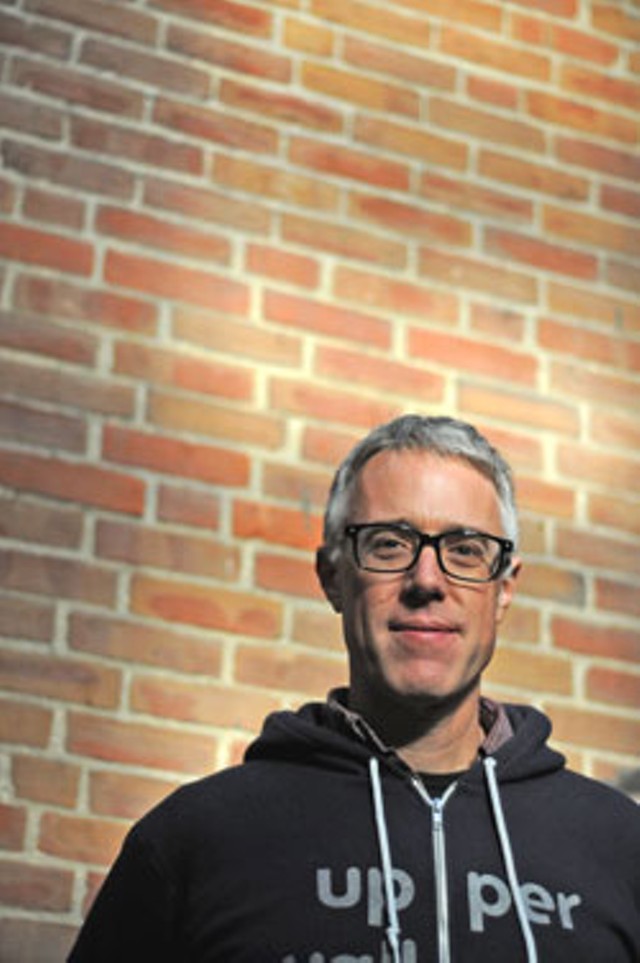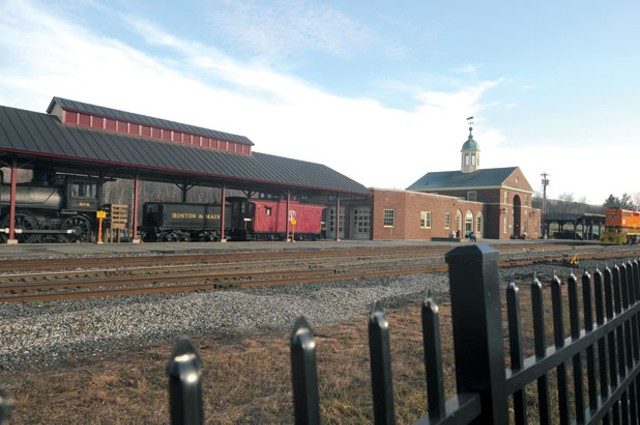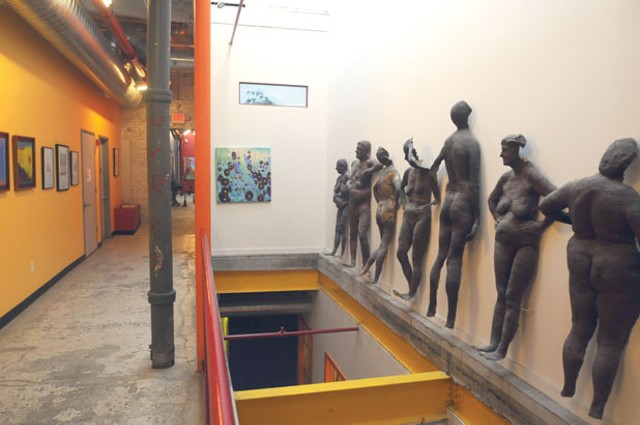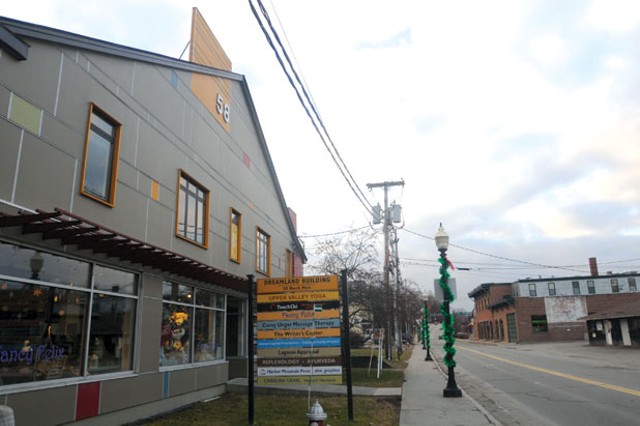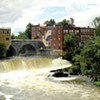Published December 11, 2013 at 11:22 a.m.
The only sign of activity inside the former American Legion Hall in White River Junction is the low hum of the high-tech, ultraefficient heating system, which sits incongruously amid blackened cast-iron furnaces in the back room of the gutted building. Still, you can sense the presence of the fraternal occupants who only recently vacated the premises. Dark, glistening grease coats various kitchen fixtures, and the funky reek of thousands of smoked cigarettes is so thick you can feel it on your tongue.
As he leads a tour through this boxy, midcentury building just south of the modest but busy downtown, real estate developer Matt Bucy, 50, acknowledges with a chuckle that the place requires a bit more work than does the standard fixer-upper. But the scale of this renovation project, which will extend the reach of the downtown commercial district by nearly two blocks, doesn’t seem to faze Bucy. He purchased the 22,500-square-foot property about a year ago, for $600,000; it’s his fourth major renovation project in White River in the past 20 years.
The previous three — the Hartford Woolen Mill and the Tip Top and Dreamland buildings — have already played major roles in the surprisingly rapid revitalization of this small Upper Valley village. (Along with Quechee, Wilder, Hartford and West Hartford, White River Junction is one of the five unincorporated villages that constitute the town of Hartford.)
Each of those projects followed a similar plan: Bucy purchased a tired old building whose decrepitude evoked White River’s long-lost industrial glory days. For tenants, he courted commercial and fine artists, thereby becoming one of several local trendsetters to lay down a new path for the village’s future. White River would no longer be a depressed, rough-and-tumble mill town but a nexus of Vermont’s creative economy. Which is not to say that the village couldn’t or wouldn’t hang on to certain elements from its colorful past.
The denizens of White River have embraced the changes wrought by Bucy’s improvements. It’s hard to find anyone who isn’t enthusiastic about this major transformation, and it would probably be impossible to find someone who doesn’t like Matt Bucy himself, a tall, amiable man with an easy laugh.
He’s something of a local celebrity, in fact. On a recent Monday morning in the Tuckerbox café, the de facto hub of White River Junction’s downtown, Bucy greets about every third patron who enters. “He is beloved by everybody who knows him,” says one of them to a visiting reporter. “I’m serious!”
Bucy may be the central and currently most active figure in White River’s turnabout, but he’s not the only one. He has picked up a gauntlet thrown down by an earlier generation of residents who long sought to make their village a more pleasant place to live and work. To understand what White River is and will be, it’s necessary to understand what it once was.
White River Junction's railyard. Photo by Sarah Priestap.
Conjunction Junction
The river that runs through this small village is white in name only (except in the winter), but the last word of the town’s name could hardly be more apropos. The past, present and future of this village — home to fewer than 3000 Vermonters — have been irrevocably shaped by the forces of confluence.
First there were the rivers — the reason that the village exists at all. The settlement was originally built at the site where the White River, on its way southeast from the mountains, joins up with the Connecticut River. Once a few bridges were constructed there in the early 19th century, the place became an ideal site for a trading post.
Then came the railroads. Between 1847 and 1875, developers brought no fewer than five railroad lines through the small settlement, thereby swelling the village’s population, the size of its commercial district and its wealth. These were the boom years, and they barreled into town by rail.
The Central Vermont Railway and the Connecticut River Railroad arrived in 1847; the Connecticut and Passumpsic Rivers Railroad and the Northern New Hampshire Railroad came through town in 1848 and 1849, respectively; and the short-lived 14-mile Woodstock Railway was finally completed in 1875. These lines made the village into a hub of intra- and interstate commerce. The downtown — with its hotels, depots, saloons and, later, textile mills, bakeries and factories — owes its very existence to the railroad.
Finally, there were the roads. Now known to motorists as the point where Interstates 89 and 91 meet — a conjunction made possible by construction crews in 1969 — White River Junction is also the place where the east-west U.S. Route 4 intersects the north-south U.S. Route 5. If you’re driving across eastern Vermont from almost any direction, on almost any road, you have to make an effort to avoid passing through White River.
The meeting of the highways was a boon to big-box retailers and chain restaurants, which flourished just across the river in tax-free New Hampshire. It also helped hotel chains, which opened locations just off the highway in White River. But that growth occurred a mile or more from the Junction’s village core, and few tourists or commercial truck drivers visited the village center.
The railroads brought the boom, and the highways brought the bust. As less and less vehicular and commercial traffic found its way downtown, factories, warehouses and mills shut their doors, leaving hulking buildings to a decades-long period of decay.
The sucker punch came when the railroads themselves fell into decline. By the 1970s, semis were hauling much of the cargo that had once filled freight trains, leading some of the rail lines to discontinue service to White River altogether.
The interstate interchange is the most recent of the village’s historic convergences, and the last that could be charted by mapmakers and surveyors. But there’s another, less measurable convergence that has given just as much definition to White River Junction. It’s more of a creative and even emotional one, but no less real. In recent years, the town’s blue-collar identity has converged with the so-called creative economy.
It’s impossible to discuss the renewal of White River without referring to Northern Stage and the Center for Cartoon Studies. This small village is home to both a professional regional theater company and an internationally renowned school of graphic arts — a claim that few, if any, similar-size towns could ever hope to make.
More than any others, these two entities embody the notion of White River’s creative economy. Not only do both Northern Stage and CCS employ artists, but, in attracting patrons of the arts to the town, their very presence stimulates the local economy, inspiring visitors to take in a meal before the show, a cup of coffee after the exhibit, local shopping while in town for the weekend. Were it not for the artsy vibe that Northern Stage and CCS bring to White River Junction, there would likely have been no influx of other artists setting up shop there.
Catherine Doherty, 54, is Northern Stage’s producing director. She notes that it was not a simple task to establish a theater company in White River, but that it would have been even more difficult without the support of locals. “We’ve been navigating a nonprofit in a very challenging economic time,” Doherty says, “but the Upper Valley saw us through … The subscriber base and the community have stayed behind us.”
In White River Junction, past, present, future, art and commerce are hitched to each other like so many train cars. And, at the moment, Matt Bucy is operating the switchyard.
Interior of the Tip Top building. Photo by Sarah Priestap.
Staying Home
Bucy is nothing if not motivated. The Wyoming native bought his first property, the former Hartford Woolen Mill, when he was just 29 and had no experience as a developer. At the time, he didn’t even feel particularly connected to White River. “I thought I was going to move to New York City,” he says. “But then I thought maybe I could just sort of do the ‘New York’ thing up here.”
He financed the purchase and renovation of the building by maxing out six credit cards, and, studied the fundamentals of construction so he could do it himself. Prospective tenants started calling him up before he even formally owned the building.
Bucy’s father, appalled by his son’s use of credit cards to finance real estate development, stepped in to help him out financially; along the way, Bucy taught himself everything he needed to know about finance. “I think I ended up with a better understanding of all that stuff than my father,” he says.
With the debt paid off and all 10 of the building’s artists’ spaces rented, Bucy moved on to his next project: a complex on North Main Street that had housed a variety of commercial bakeries since the 1880s.
“I worked right next to it for almost 10 years but had never even set foot in it,” says Bucy, referring to his days as a programmer at the pioneering, now-defunct software company New England Digital. “It was an amorphous blob of a building, and it didn’t really have any street presence … For a building of that size, it was pretty inexpensive, but it needed millions of dollars of work.”
After charting out a series of financial projections on the property, Bucy was convinced it was a sound investment. Upon purchasing it, he decided to renovate the exterior first, thereby establishing the property’s curb appeal.
Bucy held an open house at the property in December 2001, not expecting much response. “Seven hundred people showed up. It was crazy,” he says. That very day, Bucy chalk-marked the floors of the Tip Top Media and Arts Building, as it has since been rechristened, to demarcate the layouts of its rental spaces. The whole place was rented out within three weeks.
It is still rented out, and to a diverse array of tenants. The Tip Top’s 41 spaces host, among others, a public-access TV station, a puppet maker, massage therapists, a ballet studio, and numerous painters and sculptors. Google rents a small space there, too — the odd one out amid all these nontraditional businesses; former state senator and nearby resident Matt Dunne is the company’s director of community affairs. Bucy’s own office is in the Tip Top, as well.
The Tip Top is Bucy’s flagship project, and no visitor to White River can miss it. It’s anchored by the Tip Top Café, a well-regarded American bistro with a lively menu. Along with another restaurant, Elixir, just across the street from the Legion hall, the café is one of the local businesses that have helped White River transform itself from a “drive-by” town into a destination.
Bucy’s next project, dubbed the Dreamland Building, was less ambitious in scale, but its occupants are equally varied: They include a yoga studio, a theatrical supply company and a writers’ workshop. Its parti-colored exterior quotes architectural elements from the buildings on either side of it, a design decision that suggests Bucy is sensitive to the village’s past.
Still, he says he’s “not a huge history buff” — that is, he’s not afraid to lay a path for the future without referring to the past. “I have no trouble with memorializing or even celebrating the past. I think that’s great,” Bucy says. “But it is in the past. I’m definitely a future thinker; I’m much more interested in what will happen in 20 to 30 years.”
That impulse is reflected in his ideas for the American Legion Hall, for which Bucy is planning something quite different from his previous projects: a mix of commercial and residential rental spaces. “I still want to keep catering to the creative energy. That’s really healthy for a downtown,” he says. “But the thing that’s missing, especially on South Main Street, is quality housing … A lot of [residential rentals] here have been worn down. There’s nothing like a modern apartment building downtown.”
Students at CCS are among those who stand to benefit from downtown housing: The Legion building is across the street from the school, and its small, affordable apartments would be well suited for student life. James Sturm, cofounder of CCS, is enthusiastic about the project. “We’ve had three or four other developers contact us about wanting to build dorms,” he says, “but we’re not in the dorm business. As a school, we can’t do that … Here’s the thing about Matt: He’s an ‘if you build it, they will come’ sort of guy.”
David Briggs has lived in White River Junction nearly all his life. The landlord and developer of several key properties here — including the Hotel Coolidge and the Briggs Opera House, where Northern Stage performs — he has for decades led the charge to remake his hometown. Briggs was one of several forward-thinking residents who, as early as the 1970s, introduced the concepts of “sprawl” and “downtown revitalization” into the conversation about White River’s future.
Is he concerned that Bucy has supplanted him as the village’s leading voice for change? “Holy smokes, no. It’s a total vindication,” Briggs says. “I’m thrilled. [Bucy’s work] indicates the completeness of the process of White River being restored … You’d have to be kind of nutty not to celebrate it to the max.”
For Briggs, one of the chief problems over the last century of White River’s economic history is that business owners had no connection to the village itself. They lived elsewhere, and, when their factories closed, they simply fired their employees, turned off the lights and left town.
Briggs believes that having better residential options in town — such as those Bucy is proposing for the Legion hall — will reverse that course. “People will call [White River Junction] home. They haven’t done that since 1910.”
While the plans for the Legion building are not yet certain, Bucy is considering several nontraditional options, one of which is to turn part of the building’s first floor into a “coworker facility.” He envisions a central open space surrounded by small, glassed-in private offices, each of which could be rented on a short-term basis by, for instance, freelance writers or students at the cartoon school.
The second floor would hold the 21 small apartments that Bucy estimates the space could support. Above that, on the 11,000-square-foot roof, he hopes to install solar panels. Those, along with extra insulation and the ultraefficient heating system, could enable the building to operate at near net-zero energy levels.
Bucy hopes to complete the permitting process by February 2014 and to begin construction by March or April. He’s already fielding calls from construction companies that wish to bid on the project.
Lori Hirshfield, director of planning and development for the town of Hartford, says “the potential is incredible” in the Legion building. “The thing about Matt is that he comes up with quality projects,” she says. “There’s no question in my mind that he’ll do something that’s going to make a contribution to the downtown.”
The Dreamland Building. Photo by Sarah Priestap.
Creative Community
Ken Parker, owner of a local insurance agency and a member of the Hartford selectboard, has lived in White River Junction nearly all his life. He says of Bucy, “[He’s] a thoughtful, enterprising individual who has brought innovation and creativity to repurposing a couple of old structures in town. For that, I think he’s certainly owed a note of gratitude for his visions and his belief that Hartford is a good place to do business.”
Parker also praises Bucy’s efforts to cultivate an artistic community in White River Junction, noting that the Tip Top Building, for example, now boasts “an artful vibrancy that is pretty pervasive and inviting.”
Perhaps the cornerstone of that artistic community is the Main Street Museum, founded in 1992 by David Fairbanks Ford. Brimming with vintage ephemera, such as dog-chewed Frisbees, pop-culture detritus and fanciful taxidermy, the museum playfully challenges the very notion of what constitutes “proper” art.
Ford was one of the first people to contact Bucy about securing studio space in the Hartford Woolen Mill. Soon after their meeting, the two began dating; as Ford puts it, “We were the only two gay men in town.” They were a couple until about 1997 and remain good friends.
Ford is as enthusiastic as anyone about the last two decades of change in White River Junction, but he retains a fondness for the village’s past. “I kind of loved the town more [20 years ago],” he says, “because it was funkier and down and out.” He recalls a moment when he and Bucy, walking down South Main Street, heard a scream and looked up to see a television set flying out of a second-story window. “That’s local color,” he says.
Ford, though an artist himself, is concerned that the creative economy may prove unsustainable. “Someone who is out of work and living in a crummy apartment — how do they benefit from [the local arts scene]?” he asks.
He notes that local artists and artisans spend a lot of money in town: They help support restaurants, local shops and landlords. Yet, as artists, they are not likely to be on the path to great wealth. “We’ve got to figure out in our society how we’re going to fund people who are doing this work,” Ford says.
Sturm is more optimistic about fostering White River Junction’s artistic community. “What choice does the town have?” he asks. “It’s not going to be a retail giant, being on the New Hampshire border” — referring to that state’s lack of a sales tax. “We had a downtown like Swiss cheese with all these holes in it, with underutilized infrastructure. That’s great for the arts.”
Several local ventures may augur the convergence of White River’s artistic and business communities. One of these is Scavenger Gallery, a boutique operated by acclaimed jewelry designer Stacy Hopkins; another is Revolution, an upcycled-clothing store run by Kim Souza. Both businesses are right downtown, and both sell stylish, well-designed goods to customers with discerning eyes.
Initially, Hopkins wasn’t sure that her high-end jewelry would find buyers in White River. “But it’s been working,” she says. “We’re creating a steady clientele of people who tell their friends about us … I feel pretty confident that [White River] is moving in a direction that’s good for artists.”
Souza concurs. “Even though I’m running a commercial retail store,” she says, “I’m showcasing a number of artists … I didn’t want to get into retail for the sake of retail. I don’t even care about retail.”
Another local artist who has found great success in business is Bucy himself. Never mind his commercial ventures; he doesn’t even call himself a real estate developer. His business card reads, “Matt Bucy, Filmmaker and Director of Photography.”
Bucy has been out of town a lot lately, shooting a film project in Connecticut. With the help of his sole employee, Jacob Colby, and his ever-present iPhone, he keeps tabs on his business even when away from White River.
“Filmmaking is not unlike building development,” Bucy says. “In terms of the number of people involved, the schedules, the hierarchy that exists — it’s very similar. Being a general contractor totally prepared me for being on a film set.”
One of his upcoming projects, in fact, demonstrates how Bucy himself embodies the convergence implicit in the term “creative economy.” In the months before the American Legion renovations get under way, Bucy will use the place as a soundstage for a planned web series about a young woman who is magically able to communicate across time with her grandfather — who just happens to be Andy Warhol.
“I still don’t really know what the creative economy is,” Bucy says. “I went to a conference about it, and I’m still not clear on it. I think it just means entrepreneurs doing creative stuff on their own: the power of the little person. And it doesn’t strike me as anything new.”
Even so, since Matt Bucy has been investing in it, there’s a great deal of the new in White River Junction.
Inside White River Junction's American Legion Hall. Photo by Sarah Priestap.
The original print version of this article was headlined "At the Crossroads"

Matt Bucy. Photo by Sarah Priestap.
More By This Author
Speaking of...
-

REDCAN Restaurant Coming to White River Junction
Apr 16, 2024 -

Q&A: Catching Up With the Champlain Valley Quilt Guild
Apr 10, 2024 -

Video: The Champlain Valley Quilt Guild Prepares for Its Biennial Quilt Show
Apr 4, 2024 -

Q&A: Meet a Family in Waterbury That Embraces Halloween Year-Round
Feb 14, 2024 -

Video: Goth Family in Waterbury: Sarah, Jay and Zarek Vogelsang-Card
Feb 8, 2024 - More »
Comments
Comments are closed.
From 2014-2020, Seven Days allowed readers to comment on all stories posted on our website. While we've appreciated the suggestions and insights, right now Seven Days is prioritizing our core mission — producing high-quality, responsible local journalism — over moderating online debates between readers.
To criticize, correct or praise our reporting, please send us a letter to the editor or send us a tip. We’ll check it out and report the results.
Online comments may return when we have better tech tools for managing them. Thanks for reading.



































